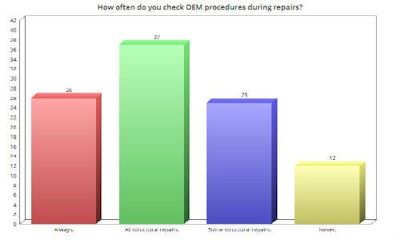
By Mike Davey
Hamilton, Ontario — September 5, 2017 — Do you and your staff always check OEM repair procedures when writing estimates? You’re not alone if you do, but it can’t really be called a standard practice, according to the results of our latest survey. The survey asked readers to let us know how often they and their staff research OEM repair procedures when writing estimates and performing repairs.
Collision Repair magazine runs a new survey every week through collisionrepairmag.com. The next survey focuses on the drive towards OEM certification and recognition. You can participate in that survey at this link.
When it comes to writing estimates, 18 percent of our respondents indicated that they “Always” looked up the OEM procedures. A further 19 percent indicated they did this “Most of the time.” The majority (40 percent) indicated that they “Sometimes” consulted OEM procedures, with another 19 percent stating that they did this “Infrequently.” Finally, four percent of respondents indicated that they “Never” checked the OEM procedures during the estimating process.
It is considered by some in the industry to be a best practice to consult the OEM procedures during the estimating process, but of course it’s possible to send supplements to the estimate. Just because a shop doesn’t do this during the estimate doesn’t mean they’re not consulting them during the repair.
However, our survey seems to show that a disturbingly high percentage are not looking up the correct procedures during the repair itself. This seems like it would open the shop up to liability if it’s found out that the work wasn’t done correctly. It might seem like you could let this slide on certain jobs, like a door ding or a small bumper hit. However, representatives of various OEMs have made it extremely clear that you should check the OEM procedures for every job, every single time. Systems that weren’t damaged in the crash may need to be recalibrated. Skipping this step may mean the system won’t function as intended. If it’s a safety or crash protection system, the potential for deadly catastrophe becomes obvious.
Leaving calibrations aside, it’s also possible that the OEM in question has changed the procedure since the last time you or one of your staff checked. Knowing the up-to-date procedures, and using them, will help to protect you and your customers.
The majority of respondents to our survey indicated they consulted OEM procedures during the repair process, at least in some cases. The single largest group, at 37 percent, check the procedures for “All structural repairs.” An additional 26 percent check them “Always” and 25 percent check for “Some structural repairs.” However, fully 12 percent of our survey respondents indicated they “Never” check the OEM procedures.
Collision Repair magazine’s next survey leaves procedures on the table, but sticks with the OEMs, looking at certification and recognition programs. Have the numbers of certified shops increased in the last year? You can let us know at this link, and make sure to watch collisionrepairmag.com next week for the results!






















